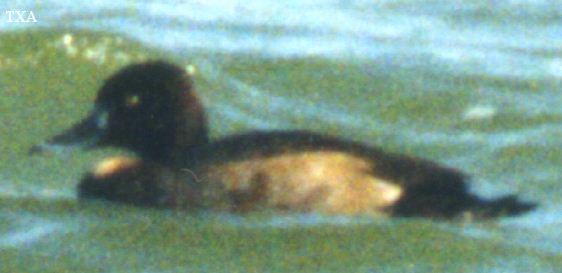

From European birders:
"Doesn't look especially good for Tufted Duck to me, but
on these pics alone
nor does it for Scaup, Lesser Scaup or duff Ring-necked... Did
you see the
wing-bar? Perhaps a horrid hybrid? As you say, hopefully it will
remain for additional scrutiny (and better photos?) Not sure what
the pale at the bill-base is and the bill looks very big. I really
wouldn't like to stick my neck out yet!"
"Took a very quick look at your female duck pictures.
While in no way a
'duckophile', I am not convinced it is a Tufted. I agree the black
bill tip is rather restricted also, perhaps too much so for Tufted?
Likewise, the forehead doesn't look steep enough and seems more
Scaup-like. It is hard to make out the 'tuft' in the scans. Presumably
the tuft grows as birds molt from juvenile to first-basic plumage?
So it is possible it is a bird of the year? I would certainly
expect adult females to have a much more obvious tuft by now.
"
"I had a quick look at your Aythya-duck, it sure looks strange. I see thousands of Tufted ducks every year in Norway, I have a flock of 400 wintering just around the corner. I check them over and over again, hoping to find a Ring-necked or a Lesser Scaup, so far without luck. I have never seen anything like your bird. The head and bill (too long, too much hook-billed) shape seems all wrong for tufted, I think you are dealing with a hybrid. The head of a tufted duck typically has a steeper forehead, with the highest point shifted to the front, compared to other Aythya species. I agree that it seems to have little black on the bill nail. It could very well be a hybrid with tufted as one of the parent species, my guess for the other parent based on the long bill will then be Greater Scaup (or possibly Ring-necked duck). Female hybrids are tricky indeed, but hybrids are not that rare at all. In Norway I have seen hybrid tufted x greater scaup, tufted x pochard and tufted x ring-necked duck. But, I can confirm that tufted ducks are extremely variable, especially concerning the shape and extent of the white patch at the base of the bill. "
"I do not think the Aythya-duck is a Tufted Duck. My guess
would be that it is a hybrid of a Scaup with possibly a Ring-necked
Duck. Some points:
-head shape: correct for Tufted Duck.
-bill: too large for Tufted Duck, reminds me of Scaup. The coloring
of
the bill is wrong for Scaup and Tufted Duck, and is so contrasting,
that
it reminds me of Ring-necked Duck.
-the body seems to be rather large, reminding of Scaup.
-is there really a white patch at the upper breast? None of the
Aythya-ducks have this, so this is another indication of the hybrid
origin of this duck.
-flanks: the washed-out blotchy coloration and the messy rear
flank
feathering (not sharply demarcated) shown by this duck are a feature
I
have seen on several Aythya-hybrids.
-vermiculations are never shown by Tufted Ducks. (note: this
was a transcription error of my part - there were no vermiculations
on this bird but instead pale fringes - Martin Reid)
The extent of the white patch at the base of the bill is a well-known
identification feature for separating female/immature Scaup from
Tufted Duck. In Scaup, this white patch is usually more extensive,
and extending further downwards (under/around the bill), than
in Tufted Duck. But both species are very variable regarding this
feature. I don't think I have ever read percentages of Tufted
Ducks that have white patches near the bill (or on the undertail).
I think the same variable situation occurs as in (Lesser) Scaup,
Ring-necked Ducks and many other Aythya-ducks. In general, aging
and sexing of Tufted Ducks is quite difficult, only a few specialists
know how to distinguish an adult female Tufted Duck from an immature
or an eclipse male plumage. For picking out a vagrant Aythya-duck,
head form and bill tip pattern are most useful. Back to the white
patch near the bill: On most Tufted Ducks that show a white patch,
the patch is above the gape only. If the white patch includes
the gape, then it is usually quite thin below the gape/bill on
Tufted Ducks, whereas on Scaups, the portion of the white patch
that extends below the gape seems to be thicker/more substantial.
Only some 10 percent (or less) of the Tufted Ducks show white
patches that are extensive enough to resemble a typical Scaup."
"Just by chance I have noticed that three out ot 4 female
Lesser Scaups I have looked at closely recently had white on on
the undertail coverts. I happened to notice this while casually
searching for a female Tufted Duck locally recently. Incidentally,
it's my recollection that many Tufted Ducks don't show white UTC.
After all, aren't obvious white UTC a useful mark for helping
find Ferruginous Ducks? It's possible that the white on the UTC
of Lesser Scaup are more restricted than that of many Tufted Ducks."
KEEP IN MIND that the above comments were made back in 1999
with only about half of the photos scanned, and I was using a
different-sized monitor, which affects the degree of contrast
seen when viewing on a a monitor that is not the same size as
that used by the image- preparer; the latest images were made
using a 17" monitor.